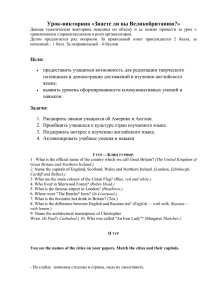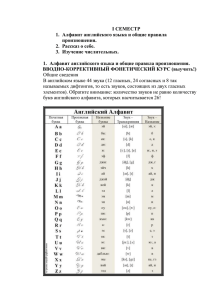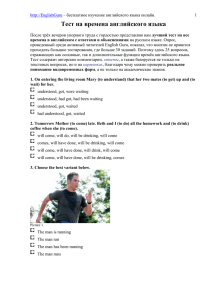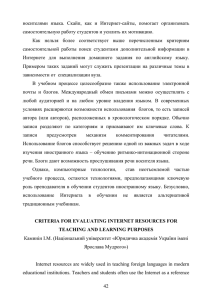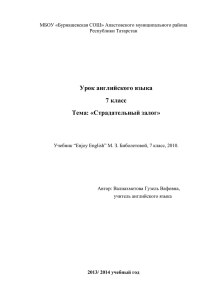История языка и введение в спецфилологию
advertisement
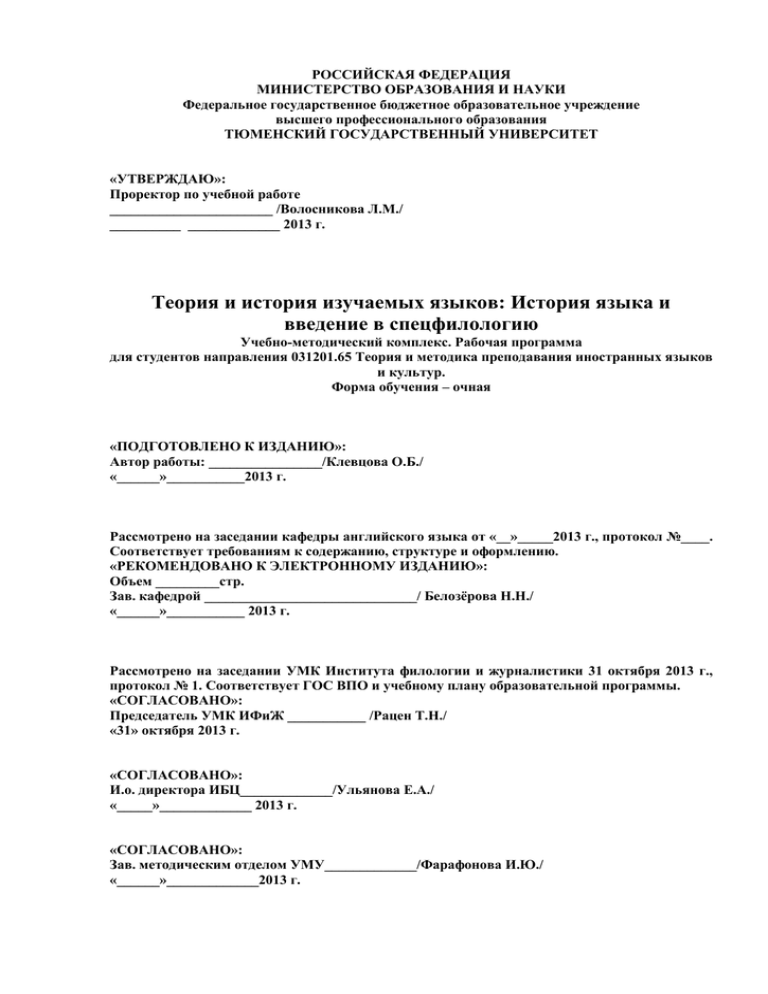
РОССИЙСКАЯ ФЕДЕРАЦИЯ МИНИСТЕРСТВО ОБРАЗОВАНИЯ И НАУКИ Федеральное государственное бюджетное образовательное учреждение высшего профессионального образования ТЮМЕНСКИЙ ГОСУДАРСТВЕННЫЙ УНИВЕРСИТЕТ «УТВЕРЖДАЮ»: Проректор по учебной работе _______________________ /Волосникова Л.М./ __________ _____________ 2013 г. Теория и история изучаемых языков: История языка и введение в спецфилологию Учебно-методический комплекс. Рабочая программа для студентов направления 031201.65 Теория и методика преподавания иностранных языков и культур. Форма обучения – очная «ПОДГОТОВЛЕНО К ИЗДАНИЮ»: Автор работы: ________________/Клевцова О.Б./ «______»___________2013 г. Рассмотрено на заседании кафедры английского языка от «__»_____2013 г., протокол №____. Соответствует требованиям к содержанию, структуре и оформлению. «РЕКОМЕНДОВАНО К ЭЛЕКТРОННОМУ ИЗДАНИЮ»: Объем _________стр. Зав. кафедрой ______________________________/ Белозёрова Н.Н./ «______»___________ 2013 г. Рассмотрено на заседании УМК Института филологии и журналистики 31 октября 2013 г., протокол № 1. Соответствует ГОС ВПО и учебному плану образовательной программы. «СОГЛАСОВАНО»: Председатель УМК ИФиЖ ___________ /Рацен Т.Н./ «31» октября 2013 г. «СОГЛАСОВАНО»: И.о. директора ИБЦ_____________/Ульянова Е.А./ «_____»_____________ 2013 г. «СОГЛАСОВАНО»: Зав. методическим отделом УМУ_____________/Фарафонова И.Ю./ «______»_____________2013 г. РОССИЙСКАЯ ФЕДЕРАЦИЯ МИНИСТЕРСТВО ОБРАЗОВАНИЯ И НАУКИ Федеральное государственное бюджетное образовательное учреждение высшего профессионального образования ТЮМЕНСКИЙ ГОСУДАРСТВЕННЫЙ УНИВЕРСИТЕТ Институт филологии и журналистики Кафедра английского языка Клевцова О.Б. Теория и история изучаемых языков: История языка и введение в спецфилологию Учебно-методический комплекс. Рабочая программа для студентов направления 031201.65 Теория и методика преподавания иностранных языков и культур. Форма обучения – очная Тюменский государственный университет 2013 Клевцова О.Б. Теория и история изучаемых языков: История языка и введение в спецфилологию. Учебно-методический комплекс. Рабочая программа для студентов направления 031201.65 Теория и методика преподавания иностранных языков и культур. Форма обучения – очная. Тюмень, 2013г. Рабочая программа составлена в соответствии с требованиями ГОС ВПО с учетом рекомендаций и ПрООП ВПО по направлению и профилю подготовки. Рабочая программа дисциплины опубликована на сайте ТюмГУ: История языка и введение в спецфилологию [электронный ресурс] / Режим доступа: http://www.umk3.utmn.ru, свободный. Рекомендовано к изданию кафедрой английского языка. Утверждено проректором по учебной работе Тюменского государственного университета. Зав. кафедрой английского языка, д.ф.н., профессор Белозерова Н.Н. © ФГБОУ ВПО Тюменский государственный университет, 2013. © Клевцова О.Б., 2013. Пояснительная записка Курс читается на 3 курсе (5 семестр) и рассчитан на 152 часа. Из них – 38 часов лекционных и 38 часов практических занятий; 76 часов – самостоятельной работы. Курс читается на русском языке, в конце курса – экзамен. Требование к содержанию курса Учебно-методический комплекс Рабочая учебная программа общепрофессиональной дисциплины «История языка и введение в спецфилологию» составлен в соответствии с требованиями государственного образовательного стандарта высшего профессионального образования по направлению "Филология". Выписка из государственного образовательного стандарта дисциплины Стандарт предусматривает изучение следующих тем: Связь истории языка и истории народа. Внешняя и внутренняя история языка. Синхрония и диахрония. Проблема языковых изменений. Исторические и лингвистические условия формирования изучаемого языка. Периодизация истории изучаемого языка. Критерии периодизации. Характеристика основных периодов. Эволюция форм существования изучаемого языка в ходе его исторического развития. Историческая фонетика. Становление фонологической системы изучаемого языка. Основные тенденции развития фонологической системы изучаемого языка. Историческая грамматика. Становление грамматических категорий изучаемого языка. Основные тенденции развития грамматического строя изучаемого языка. Историческая лексикология. Становление словарного состава изучаемого языка. Основные тенденции развития словарного состава изучаемого языка. Историческая стилистика. Программа дисциплины представляет собой описание цикла лекций и семинарских занятий. Изучение дисциплины «История языка и введение в спецфилологию» основано на курсах «Древние языки и культуры», «Введение в языкознание», «Социолингвистика», «Психолингвистика». В ходе освоения курса студенты приобретают навыки системного лингвистического анализа древне-, среде- и новоанглийского текстов, у них формируются умения ориентироваться в причинах и механизмах языковой эволюции английского языка. В результате изучения дисциплины студенты должны: иметь представление об исторических и лингвистических условиях эволюции английского языка и причинах языковых изменений, понимать связь истории языка и истории народа, быть знакомыми со становлением фонетической и грамматической подсистем английского языка, с эволюцией структуры и словарного состава английского языка, уметь давать историческое объяснение основных характеристик и тенденций развития английского языка, уметь анализировать древне-, среде- и новоанглийские тексты, приобрести навыки лингвистического анализа таких текстов. Цель дисциплины – дать студентам представление о процессах и закономерностях эволюции подсистем английского языка в связи с эволюцией английского народа. Задачи дисциплины: 1. объяснение факторов и процессов, оказавших влияние на становление современного английского языка; 2. рассмотрение системного характера исторических изменений английского языка в связи с историей языкового сообщества; 3. изучение взаимосвязи развития различных уровней английского языка; 4. определение закономерностей исторической эволюции английского языка; При изучении указанного теоретического курса студенты овладевают практическими навыками системного – фонетического / фонологического, грамматического, лексического, стилистического, этимологического анализа древних текстов, приобретают умения дать историческое объяснение основных особенностей древне-, среде- и новоанглийского языка. Курс готовит студентов к написанию курсовых и дипломных работ по исторической лингвистике. Итого часов по теме Итого количество баллов 14 6 0-6 Семинарски е (практическ Самостояте ие) занятия* льная работа* Виды учебной работы и самостоятельная работа, в час. Лекции* Тема недели семестра № Из них в интерактивной форме, в час Тематический план курса Модуль 1 Древнеанглийский период 1. Фонетика древнеанглийского периода 1-2 4 4 6 2. Лексический состав древнеанглийского периода 3-4 4 4 6 14 6 0-4 3. Грамматический строй древнеанглийского периода 5-6 4 4 6 14 6 0-4 4. Синтаксис древнеанглийского периода 7 2 2 4 8 6 0-4 14 14 22 50 24 0-30 Всего Модуль 2 Среднеанглийский период 1. Фонетика среднеанглийского периода 8-9 4 4 6 14 6 0-6 2. Лексический состав среднеанглийского периода 1011 4 4 6 14 6 0-4 3. Грамматический строй среднеанглийского периода 1213 4 4 6 14 6 0-4 4. Синтаксис среднеанглийского периода 14 2 2 4 8 6 0-4 14 14 22 50 24 0-30 Всего Модуль 3 Новоанглийский период 1. Фонетика новоанглийского периода 15 3 3 7 13 8 0-6 2. Лексический состав и грамматический строй нового периода 16 3 3 7 13 8 0-6 3. Коллоквиум по древнеанглийскому периоду 17 2 2 8 12 8 0-9 4. Коллоквиум по среднеанглийскому периоду 18 2 2 8 12 8 0-9 10 10 30 50 32 0-40 38 38 76 152 80 0 – 100 Всего Итого (часов, баллов): Виды и формы оценочных средств в период текущего контроля контрольная работа 1.1. Фонетика 0-1 0-1 0-2 0-2 0-2 0-8 1.2. Лексический состав 0-1 0-1 0-2 0-2 0-2 0-8 1.3. Грамматический строй 0-1 0-1 0-2 0-2 0-2 0-3 1.4. Синтаксис 0-1 0-1 0-2 0-2 Всего 0-4 0-4 0-8 0-8 0-4 0-20 тест лабораторная работа Итого количество баллов Письменные работы ответ на семинаре коллоквиумы собеседование Устный опрос № темы Модуль 1 Древнеанглийский период 0-6 Модуль 2 Среднеанглийский период 2.1. Фонетика 0-1 0-1 0-2 0-2 0-2 0-8 2.2. Лексический состав 0-1 0-1 0-2 0-2 0-2 0-8 2.3. Грамматический строй 0-1 0-1 0-2 0-2 0-2 0-8 2.4. Синтаксис 0-1 0-1 0-2 0-2 Всего 0-4 0-4 0-8 0-8 0-4 0-30 0-6 Модуль 3 Новоанглийский период 3.1. Фонетика 0-1 0-1 0-2 0-2 0-2 0-8 3.2. Лексический состав и грамматический строй 0-1 0-1 0-2 0-2 0-2 0-8 3.3. Коллоквиум по древнеанглийскому периоду 0-2 0-2 0-2 0-2 0-2 0-2 0-12 3.4. Коллоквиум по среднеанглийскому периоду 0-2 0-2 0-2 0-2 0-2 0-2 0-12 Всего 0-4 0-6 0-6 0-8 0-8 0-8 0-40 Итого 0 – 100 Планирование самостоятельной работы студентов № Модули и темы Виды СРС обязательные дополнительные Неделя семестра Объем часов Кол-во баллов 1 6 0-10 2 6 0-10 3 6 0-10 4 6 0-10 Модуль 1 Древнеанглийский период 1.1 Фонетика 1.2 Лексический состав 1.3. Грамматический строй 1.4. Синтаксис Ведение записей на лекции; Проработка лекций; Обсуждение записей в малых группах и обобщение проработанного материала; Чтение обязательной и дополнительной литературы по теме семинара; Этимологический анализ текста; Составление сравнительных таблиц. Составление сообщений; Выполнение этимологических задач. Всего по модулю 1: 24 40 Модуль 2 Среднеанглийский период 2.1 Фонетика 2.2 Лексический состав 2.3. Грамматический строй 2.4. Синтаксис Ведение записей на лекции; Проработка лекций; Обсуждение записей в малых группах и обобщение проработанного материала; Чтение обязательной и дополнительной литературы по теме семинара; Этимологический анализ текста; Составление сравнительных таблиц. 5 8 0-5 6 6 0-5 7 6 0-5 8 6 0-5 26 0-20 9 8 0-10 10 6 0-10 11 6 0-10 12 6 0-10 Составление сообщений; Выполнение этимологических задач. Всего по модулю 2: Модуль 3 Новоанглийский период 3.1 Фонетика 3.2 Лексический состав и грамматический строй 3.3. Коллоквиум по древнеанглийскому периоду 3.4. Коллоквиум по среднеанглийскому Ведение записей на лекции; Ведение записей на лекции; Обсуждение записей в малых группах и обобщение проработанного материала; Обсуждение записей в малых группах и обобщение проработанного материала; Этимологический Этимологический периоду анализ текста; Составление сравнительных таблиц. анализ текста; Составление сравнительных таблиц. Всего по модулю 3: 26 0-40 ИТОГО: 76 0-100 Содержание программы, дидактические единицы (ДЕ) дисциплины «История языка и введение в спецфилологию» приведено в соответствие с целью, содержанием и структурой теоретического курса. Курс поделен на пять разделов. Раздел 1. Связь истории языка с историей народа. Внешние и внутренние факторы эволюции. Синхрония и диахрония. Проблема языковых изменений. Раздел 2. Периодизация истории английского языка. Критерии периодизации. Характеристика основных периодов. Раздел 3. Историческое развитие фонетической подсистемы английского языка. Раздел 4. Историческое развитие лексической и стилистической подсистем английского языка. Раздел 5. Историческое развитие грамматической подсистемы английского языка. Разделы содержат лекции и семинарские занятия. Лекции включают следующие: Lecture 1. Periodisation of English. 1. Structure and content of the course «A History of the English Language». Aims of the course. 2. Synchronical and diachronical approaches to the history of a language. 3. Indo-European and Germanic Influence on the English Language. 4. Survey of periods: Old English. Middle English. Early-Modern English. Late-Modern English. Lecture 2. The Old English (OE) Period. 1. First men on the territory of England. 2. The Celts. The Romans in Britain. 3. The Germanic invaders. 4. The Vikings in Britain. Lecture 3. Old English Phonology. 1. Word stress in OE. 2. The OE vocalic system. 3. The OE consonant system. 4. OE phonetic changes. Lecture 4. Old English Lexicology. 1. The Northumbrian, Mercian, West-Saxon, Kentish dialects. 2. The early writings of the English Language. 3. OE records. 4. OE native words. 5. Ways of developing OE vocabulary. 6. OE loan-words. Lecture 5. Old English Nominal Morphology. 1. OE substantives and their categories. 2. OE adjectives. 3. OE pronouns. 4. OE numerals. Lecture 6. Old English Verbal Morphology. 1. Strong and weak verbs. 2. Preterit-present verbs. 3. The grammatical categories of aspect, tense, number, person, passive voice, mood. Lecture 7. Old English Syntax. 1. Phrase. 2. Simple sentence. 3. Parts of a sentence. 4. Word order. 5. Composite sentence. Lecture 8. The Middle English (ME) Period. 1. Effect of the Norman Conquest on the linguistic situation in England. Bilingualism in England. 2. Early and Late ME dialects and writings. Extension of English territory. Reestablishment of English as the language of the state and literature. 3. The growth of the London dialect. Written records in late ME. The age of Chaucer. Lecture 9. Middle English Phonology. 1. ME orthography: spelling changes in ME. Rules of reading. 2. The scribal traditions of the French. 3. Vowel system: quantitative changes in unstressed vowels. 4. Qualitative changes. Development of monophthongs and diphthongs. Lecture 10. Great Vowel Shift. 1. System of vowels in late ME. 2. The Great Vowel Shift. 3. Interpretations of the Great Vowel Shift. Lecture 11. Evolution of the Middle English Lexical System. 1. Scandinavian and French influence on the vocabulary in ME. 2. Borrowings from classical languages in the age of Renaissance. 3. Evolution of the ME semantics. 4. Semantic changes in ME. Lecture 12-13. Evolution of the Middle English Nominal Morphology. 1. Decay of noun declensions in ME. 2. Evolution of grammatical categories of the noun. 3. Adjective. Decay of declensions and grammatical categories of the adjective. 4. Pronouns. 5. Development of articles. Lecture 14-15. Evolution of the Middle English Verbal Morphology. 1. Simplifying changes in the verb conjugation. 2. Changes in the morphological classes of the verb. 3. Development of new grammatical forms and categories of the verb. The gerund. 4. Perfect forms. The Continuous. The Future. 5. Passive voice. 6. The Subjunctive. 7. Interrogative and negative forms with do. 8. Lecture 16. Evolution of the Middle English Syntax. 1. Development of the syntactic system in ME. 2. Phrase. 3. Simple sentence. 4. Compound and complex sentences. Lecture 17. The New English (NE) Period. 1. Expansion of English over the British Isles. 2. Literary Renaissance. 3. Development of the National Literary English Language. 4. W. Shakespeare. 5. Normalising tendencies. Grammars and dictionaries in the late 17th and 18th c. Lecture 18. New English Phonology and Lexicology. 1. Development of the New English phonology. 2. History of word-formation (the 15th – 17th c.). 3. Borrowings from contemporary languages in New English. Lecture 19. New English Morphology and Syntax. 1. Development of the New English morphology. 2. Development of the New English syntax. Темы семинаров Seminar 1. Activities. Questions for revision and discussion: 1. What are the subject and aims of the History of English? 2. Identify the causes of language evolution. 3. Explain why linguistic changes are slow and gradual. 4. Give a survey of periods in the history of English. 5. Study the Old English Alphabet and the rules of reading. Seminar 2. Activities. Questions for revision and discussion: 1. What languages were spoken in the British Isles prior to the Germanic invasion? Which languages spoken by ancient inhabitants of the British Isles have survived today? 2. What historical events account for the influence of Latin on Old English? 3. Describe the linguistic situation in Britain before and after the Germanic settlement. 4. Explain the origin of the following place-names: Britain, Scotland, Great Britain, Bretagne, Sussex, Essex, Middlesex, Wessex, Northumberland, Wales, Cornwall. Seminar 3. Activities. Questions for revision and discussion: 1. Did word stress in OE always fall on the first syllable? Characterise the word stress in the text under analysis. 2. Discuss the word stress in polysyllabic words, especially compounds. 3. In words with prefixes the position of the stress varied: verb prefixes were unaccented, while in nouns and adjectives the stress was commonly thrown on to the prefix. Give examples. 4. If the words were derived from the same root, word stress served to distinguish the noun from the verb. Give examples to prove it. 5. Was the OE vowel system symmetrical? Give your arguments. 6. Define the sound values of the letters f, đ, s and comment on the system of OE consonant phonemes. 7. What consonant and vowel changes are illustrated by the following pairs of words? GT maiza – OE māra; Gt kunþian – OE cyđan; Gt dauþs – OE dēad; Gt saljan – OE sellan; OE þyncan – þūhte; OE mæ den, mæden, Gt kinnus – OE cinn; OHG isarn – OE īren; Gt hausjan – OE hīeren; OSc skapt – OE sceaft. 8. Give examples of sound changes in OE. They are shortening, lengthening, breaking, diphthongisation, palatal mutation, palatalisation, splitting of velar consonants, loss of consonants in some positions. 9. Define the positions in which short vowels in OE became long: behindan > behīndan, climban > clīmban, camb > cāmb, milde > mīlde, sceld > scēld, rund > rūnd, ewunden > wūnden, feld > fēld. 10. How could the vowels in OE talu, findan, hopa, þrote, stolen ultimately develop into diphthongs, though originally they were short monophthongs? 11. Explain why the vowels in the following examples were not lengthened: ewyndlian, hundred, timbre, lambru (pl. of lamb), eldra, wundres (Gen. of wundor). Seminar 4. Activities. Questions for revision and discussion: 1. Make a list of OE Manuscripts. 2. Examine the etymological layers of OE vocabulary. 3. Discuss the foreign element in the OE vocabulary. 4. Why does the OE vocabulary contain so few borrowings from the Celtic languages? 5. Study the word-formation in Old English: word-derivation, sound interchanges, word stress, prefixation, suffixation, word-composition. 6. Pick out OE suffixes and prefixes which are still used in the presentday English. 7. Characterize the process of the “simplification of the morphological structure” in the nominal system. Seminar 5. Activities. Questions for revision and discussion: 1. Speak on the differences between the categories of case, number and gender in nouns, pronouns and adjectives. 2. Point out relics of the stem-suffixes in the forms of nouns. 3. Why are noun declensions in OE referred to as “stems”? 4. Explain the differences between the grouping of nouns into declensions and the two declensions of adjectives. 5. Discuss the instances of suppletion in form-building in OE. 6. Explain the terms strong and weak adjectives. 7. What form-building means were used in OE? Explain why OE can be called a “synthetic” or “inflected” language. Seminar 6. Activities. Questions for revision and discussion: 1. Define the principal forms of the strong verbs. 2. Define the principal forms of the weak verbs. 3. Speak on the theories of the origin of the dental suffix. 4. Build the principal forms of the verbs in the given text. 5. Form the weak verbs of the 1 class from the nouns dōm, lār, weorc, tācen, talu, blōd, fōda, mōt, racu, from the adjectives hāl, fūs, læt, lēoht, from verbs: drincan, rīsan, swefan, faran, drīfan. 6. State the class of the following weak verbs according to the suffix of the infinitive: wīcian, læfan, bētan, spellian, dwellan. 7. Analyse the shift of meaning in the verbs: cuman – ofer-cuman, sittan – be-sittan, þencan – be-þencan, bađian – be-bađian. 8. Reconstruct the derivational morpheme in the weak verbs: dēman, læran, andswarian, wundian, fyllan, fiscian, hælan, læfan, nemnan. 9. Discuss the peculiarities of the word-formation in the preterit-present verbs. 10. Define the forms of the following preterit-present verbs: witon, durron, du on, sculon, cunnon, þurfon. 11. Analyse the past tense forms of the preterit-present verbs wiste, mōste. 12. Define the shift of meaning in the preterit-present verbs in OE. 13. State the morphological and semantic peculiarities of the anomalous verbs: OE eom – OSlav eсмь, OE bēon – Lat fui, Russ быть, OE willon – Lat vello, Russ неволить, OE dōn – Lat facio, Russ делать, OE ān – Gk i-thi. 14. Analyse the non-finite forms of the verbs in OE. Did they have more nominal features in OE? Seminar 7. Activities. Questions for revision and discussion: 1. Characterise the syntactic structure of OE. 2. Describe the OE word phrases. 3. Describe the parts of the simple sentence in OE. 4. Prove that the order of words in the OE sentence was relatively free and the position of words in the sentence was often determined by logical and stylistic factors rather than by grammatical constraints. 5. Study the connectives in OE. Seminar 8. Activities. Questions for revision and discussion: 1. Explain why the earliest effect of the Norman Conquest was a drastic change in the linguistic situation. 2. Study the sources of the ME dialects. 3. Prove that the victory of English was predetermined and prepared for by previous events and historical conditions. 4. Study the role of Geoffrey Chaucer in English Literature. 5. Account for the shift of the dialectal type of the speech of London in the 14th c. 6. Why did the London dialect in the 15th and 16th c. become the basis of the national literary English language? Seminar 9. Activities. Questions for revision and discussion: 1. Compare the system of vowels in OE and ME. 2. What are the causes of vowel interchange in NE keep – kept, feel – felt, wise – wisdom, leave – left, five – fifth? 3. Account for the interchange of vowels in NE child – children, wild – wilderness, bewilder, behind – hindrance. 4. Give a historical explanation of different spellings of the following homophones: son – sun, meet – meat, see – sea, rein – rain, vein – vain, soul – sole, main – main, flour – flower, so – sow, law – lore, bare – bear, root – route, rode – road. Were thse pairs homophones in ME? 5. Account for the sound values of the letter c in the following words: mercy, copper, class, special, sufficient. 6. Show how modern spelling can help to reconstruct the phonetic history of the words: drive, might, keen, mete, lake, loaf, boot, about, low, draw, cast, applaud, cart, ant, warn, burn, first, nun, none, bony, knee, limb. 7. Explain the origin of the different sound values of the following digraphs: ea in seat, dead; ie in chief, lie; ou in pound, soup, soul, rough; ow in sow, how. 8. Recall the development of OE [y, y:] and explain the differences in the pronunciation and spelling of merry, hill, busy, buy, evil, bury (OE words with short y), sleeve, fist, mice, sundry (OE words with long y:). Seminar 10. Activities. Questions for revision and discussion: 1. Describe the system of vowels in ME. 2. Why was the series of changes of long vowels between the 14th and the 18th c. given the name the Great Vowel Shift? 3. Determine the content and the nature of the Great Vowel Shift. 4. Compare the theories of the Great Vowel Shift introduced by K.Luick (the theory of “push-chain”), O.Jespersen (the theory of “drag-chain”) and V.Plotkin (morphological interpretation). Seminar 11. Activities. Questions for revision and discussion: 1. Compare the position of the Old Scandinavian and Anglo-Norman (French) in early ME. 2. Identify the semantic spheres of Anglo-Norman borrowings. 3. Give the examples of the loan-words in the age of Renaissance. 4. Describe the events of external history which favoured the growth of the national literary language. 5. Could the efforts made by men-of-letters in the “normalisation period” stop the changes in ME and improve the language? 6. Comment on the quotation by J.Hart “The flower of the English tongue is used in the Court of London” (1570). Seminar 12. Activities. Questions for revision and discussion: 1. Describe widening and narrowing of meaning. 2. Describe methaphoric and metonymic shifts of meaning. 3. Give examples of words of concrete meaning acquiring a more general, non-concrete meaning through metaphoric use. 4. Prove that the main direction of the development for the nominal parts of speech can be defined as morphological simplification. Seminar 13. Activities. Questions for revision and discussion: 1. Why has the period between 1000 and 1300 been called an “age of great changes” (A.Baugh) ? Seminar 14. Activities. Questions for revision and discussion: 1. Compare the evolution of the verb and noun systems. 2. Was analytical form-building equally productive in all the parts of speech? 3. Describe the evolution of analytical forms from free word groups (syntactical constructions) to grammatical forms. Seminar 15. Activities. Questions for revision and discussion: 1. In ME the order of words in the sentence underwent noticeable changes. Describe them. 2. Trace the evolution of predicative constructions in OE and ME. 3. Prove that the differentiation between compound and complex sentences in ME became more evident and the use of connectives – more precise. Seminar 16. Activities. Questions for revision and discussion: 1. Prove that by the end of the Early NE period the area of English had expanded to embrace the whole of the British Isles with some exceptions (parts of Wales, Scotland, Ireland, the Isle of Man, Cornwall). 2. Characterise the period of the Renaissance in England. 3. How did the extralinguistic factors such as the economic and political unification of the country, the progress of culture and education, the flourishing of literature influence the establishment of the written standard ? 4. The age of the literary Renaissance was followed by the period of “fixing the language”. Describe its main concepts and ideas. 5. Why does the dating of the development of the Spoken Standard appear to be problematic ? Consider the following: there was no ME standard language, but a number of inter-related dialects. In NE period educated men and women wrote in the standard but many continued to speak in the dialect of their region. John Aubrey, writing in the mid-17th c., says of Sir Walter Raleigh (1552 - 1618): Old Sir Thomas Malett, knew Sir Walter, and I have heard him say, that notwithstanding his so great Mastership in Style and his conversation with the learnedest and politest persons, yet he spake broad Devonshire to his dying day. Seminar 17. Activities. Questions for revision and discussion: 1. Why does the letter e stand for [e] in bed, for [i:] in he, for the nuclei [i] and [ε] of diphthongs in here and there? 2. Why does the letter o stand for [o] in not, for [ou] in bone, [] in front and some, and for [o:] when followed by r: more, port? 3. Why does the letter x stand for [ks] and [gz] in the following words: oxen – axes – example, execute – executor – executive, exercise – examine – exact – exist? 4. Explain from a historical viewpoint the pronunciation of the following words with the letter g: good, again, general, change, regime. 5. Account for the “discrepancy” between pronunciation and spelling in Mod E. Give examples of phonetic and conventional spellings. Prove that written form indicates the earlier pronunciation of the word. 6. Give the modern descendants of the following words, which developed in accordance with regular phonetic and spelling changes: OE hind, spēdi , dūst, sceaft, scīnan, snāwan, rædan, hearm, sceal, wearm, cēap, butere, bōc, metan, hund, hundred, hwæt, tūn, steorfan, þræd, smoca, drīfan, bana, dēop, āđ. 7. Account for the mute letters in late, sight, wrong, often, bomb, autumn, course, knowledge, honour, what, whole, guest, pneumonia, psalm. 8. Define the origin of the following words: pack, scour, spool, stripe, armada, barricade, cannibal, cargo, embargo, escapade, balcony, cameo, corridor, cupola, design, fresco, gallery, granite, parapet, bowline, buoy, cruise, deck, dock, freight, keel, skipper, kindergarten, halt, stroll, plunder, poodle, waltz, muzhik, rouble, troika, tsar, verst, astrakhan,, beluga, barrack, cash, canteen, escort, gallop, manage, medal. Seminars 18-19. Activities. Questions for revision and discussion: 1. Compare the historical productivity of different form-building means: synthetic (inflections, sound interchange), analytical, suppletive. 2. Which part of speech has lost the greatest number of grammatical categories? 3. Which part of speech has acquired new categories? 4. Describe the sources of the modern plural forms of nouns and the spread of the ending – (e)s. 5. Compare the development of case and number in nouns, adjectives, pronouns. 6. Trace the history of the pronouns she, they, their, him, you, its. 7. What is the connection between the growth of the articles, the history of the pronouns and the decline of the adjectival declensions? 8. Point out traces of the OE preterit-present verbs in modern modal verbs. Контрольные вопросы к экзамену (зачету) По окончании курса проводится экзамен. Он включает 2 теоретических и один практический вопрос. Последний предполагает фонетический, лексический, грамматический и этимологический анализ древнеанглийского предложения и разбор эволюционных «цепочек» (изменения в орфографии, произношении, морфологии древне-, средне- и новоанглийского слова). Контрольные вопросы к экзамену: 1. Periodisation of the English Language. Definition of periods. Old English period. Historical background: Indo-European and Germanic Influences on the English language. 2. Primitive society on the territory of the British Isles. The Celts. The Romans in Britain. 3. The Germanic invaders. The anglo-saxon tribes and how they live. The Vikings in Britain. Strengthening of the kingdom in the reign of Alfred the Great. 4. Ways of developing OE vocabulary. 5. OE native words. The words of Indo-European and Germanic origin. 6. Latin, Celtic and Scandinavian loan-words in OE. The influence of the Scandinavian dialects on the English Language. 7. The early writings of the English Language. The runes. The Latin alphabet. 8. The Northumbrian, Mercian, West-Saxon, Kentish dialects in OE. Old English records. 9. The structure of the OE phonology. OE vocalic system. Later evolution of the OE vowels (OE phonetic changes). 10. The prehistoric evolution of the OE consonant system. Syntagmatic changes of the OE consonants. 11. OE morphological system. OE substantives and their categories. 12. OE adjectives. OE pronouns. OE numerals. 13. Strong and weak verbs in OE. 14. Preterit-present and anomalous verbs in OE. 15. The grammatical categories of aspect, tense, number, person, passive voice, mood in OE. 16. Simple sentence in OE. Parts of a sentence and word order in OE. 17. Composite sentence in OE. Compound and complex sentences. 18. The Norman Conquest of Britain. Diglossia (concurrent existence) and bilingualism. Effect of the Norman Conquest on the linguistic situation in England. 19. ME orthography: spelling changes and rules of reading in ME. 20. ME Phonology. Vowel system: quantitative changes. 21. Qualitative development of monophthongs and diphthongs in ME caused by the elimination of the quantitative oppositions. 22. Development of consonants in ME. 23. Great vowel shift. Interpretations of the Great Vowel Shift. 24. Early ME dialects and writings. Extension of English territory. 25. Late ME. Reestablishment of English as the language of the state and literature. 26. Dialects of late ME. 27. The growth of the London dialect. Written records in late ME. The age of Chaucer. 28. ME morphology. Decay of noun declensions in ME. 29. Grammatical categories of the noun in ME. The gradual loss of the “relational” categories and the strengthening of the “nominative” categories. 30. The pronoun. The evolution of the categories of the pronouns. Development of articles in ME. 31. Decay of declensions and grammatical categories of the adjective in ME. The change in the paradigm of the adjectives. 32. Simplifying changes in the verb conjugation in ME. Changes in the morphological classes of the verb. 33. Development of new grammatical forms and categories of the verb in ME. 34. The evolution from synthetism to analytism. Analytical formations in ME. 35. ME lexicology. Word-formation. 36. French influence on the vocabulary in ME. 37. Borrowings from classical languages in the age of Renaissance. 38. The simple sentence in ME. 39. Compound and complex sentence in ME. 40. New English period. Development of the National Literary English Language in the 17th – 18th c. 41. The social and cultural trends affecting language. Expansion of English over the British Isles in NE. 42. Literary Renaissance in NE. 43. Establishment of the written standard. 44. Normalising tendencies. Grammars and dictionaries in the late 17th and 18th c. The orthography of the 18th c. 45. Borrowings from contemporary languages in NE. 46. History of word-formation (the 12th – 17th c.). 47. The evolution of the modern English phonological system. Changes of prosodic correlation from contact to morphosyllabism resulted in the increased number of close contact words (thereby increasing the number of words with the coinciding syllable and morpheme boundaries). 48. NE morphology. The trends and tendencies of the evolution of modern English morphological system. 49. NE syntax. Темы для самостоятельной работы 1. Periodisation of the English Language. Definition of periods. Old English period. Historical background: Indo-European and Germanic Influences on the English language. 2. Primitive society on the territory of the British Isles. The Celts. The Romans in Britain. 3. The Germanic invaders. The anglo-saxon tribes and how they live. The Vikings in Britain. Strengthening of the kingdom in the reign of Alfred the Great. 4. Ways of developing OE vocabulary. OE native words. The words of Indo-European and Germanic origin. 5. Latin, Celtic and Scandinavian loan-words in OE. The influence of the Scandinavian dialects on the English Language. 6. The early writings of the English Language. The runes. The Latin alphabet. The Northumbrian, Mercian, West-Saxon, Kentish dialects in OE. Old English records. 7. The structure of the OE phonology. OE vocalic system. Later evolution of the OE vowels (OE phonetic changes). 8. The prehistoric evolution of the OE consonant system. Syntagmatic changes of the OE consonants. 9. OE morphological system. OE substantives and their categories. 10. OE adjectives. OE pronouns. OE numerals. 11. Strong and weak verbs in OE. Preterit-present and anomalous verbs in OE. 12. The grammatical categories of aspect, tense, number, person, passive voice, mood in OE. 13. Simple sentence in OE. Parts of a sentence and word order in OE. Composite sentence in OE. Compound and complex sentences. 14. The Norman Conquest of Britain. Diglossia (concurrent existence) and bilingualism. Effect of the Norman Conquest on the linguistic situation in England. 15. ME orthography: spelling changes and rules of reading in ME. 16. ME Phonology. Vowel system: quantitative changes. Qualitative development of monophthongs and diphthongs in ME caused by the elimination of the quantitative oppositions. 17. Development of consonants in ME. Great vowel shift. Interpretations of the Great Vowel Shift. 18. Early ME dialects and writings. Extension of English territory. 19. Late ME. Reestablishment of English as the language of the state and literature. Dialects of late ME. The growth of the London dialect. Written records in late ME. The age of Chaucer. 20. ME morphology. Decay of noun declensions in ME. Grammatical categories of the noun in ME. The gradual loss of the “relational” categories and the strengthening of the “nominative” categories. The pronoun. The evolution of the categories of the pronouns. Development of articles in ME. 21. Decay of declensions and grammatical categories of the adjective in ME. The change in the paradigm of the adjectives. 22. Simplifying changes in the verb conjugation in ME. Changes in the morphological classes of the verb. Development of new grammatical forms and categories of the verb in ME. The evolution from synthetism to analytism. Analytical formations in ME. 23. ME lexicology. Word-formation. 24. French influence on the vocabulary in ME. Borrowings from classical languages in the age of Renaissance. 25. The simple sentence in ME. Compound and complex sentence in ME. 26. New English period. Development of the National Literary English Language in the 17th – 18th c. 27. The social and cultural trends affecting language. Expansion of English over the British Isles in NE. 28. Literary Renaissance. Establishment of the written standard. Normalising tendencies. Grammars and dictionaries in the late 17th and 18th c. The orthography of the 18th c. 29. Borrowings from contemporary languages in NE. History of wordformation (the 12th – 17th c.). 30. The evolution of the modern English phonological system. 31. NE morphology. The trends and tendencies of the evolution of modern English morphological system. 32. NE syntax. Учебно-методическое обеспечение самостоятельной работы студентов. Оценочные средства для текущего контроля успеваемости, промежуточной аттестации по итогам освоения дисциплины. Самостоятельная работа студента заключается в составлении конспектов, изложении материала в тетради, выполнение письменных заданий – контроль осуществляется путем проверки тетрадей, предъявления конспектов. Самостоятельная работа по подготовке к тестам проверяется в процессе написания письменных контрольных работ и тестов; студент отчитывается по темам модулей, синтезируя полученные знания в устном ответе; студент создает собственные контрольно-измерительные материалы, предъявляемые на практических занятиях. Основная литература 1. Гуревич, П.С. Культурология [Электронный ресурс] : Учебник / П.С. Гуревич. - М.: Юнити-Дана, 2012.- 328с. Режим доступа: http:biblioclub.ru\index.php?page=book&id=115380 (дата обращения 27.09.2013). Дополнительная литература 1. Иванова, И. П. Практикум по истории английского языка: учеб. пособие для студентов пед. ин-тов по спец. 2103 "Ин. яз."/ И. П. Иванова, Т. М. Беляева, Л. П. Чахоян. - Москва: Просвещение, 1985. - 159 с. 2. Мороховский, А. Н. Слово и предложение в истории английского языка/ А. Н. Мороховский. - Киев: Вища школа, 1980. - 215 с.; 20 см. - 202-214с. 3. Вендина, Т. И. Введение в языкознание: учеб. пособие для студ. пед. вузов по спец. 032900 "Рус. яз и лит-ра"/ Т. И. Вендина. - 2-е изд., испр. и доп. - Москва: Высшая школа, 2005. - 391 с
